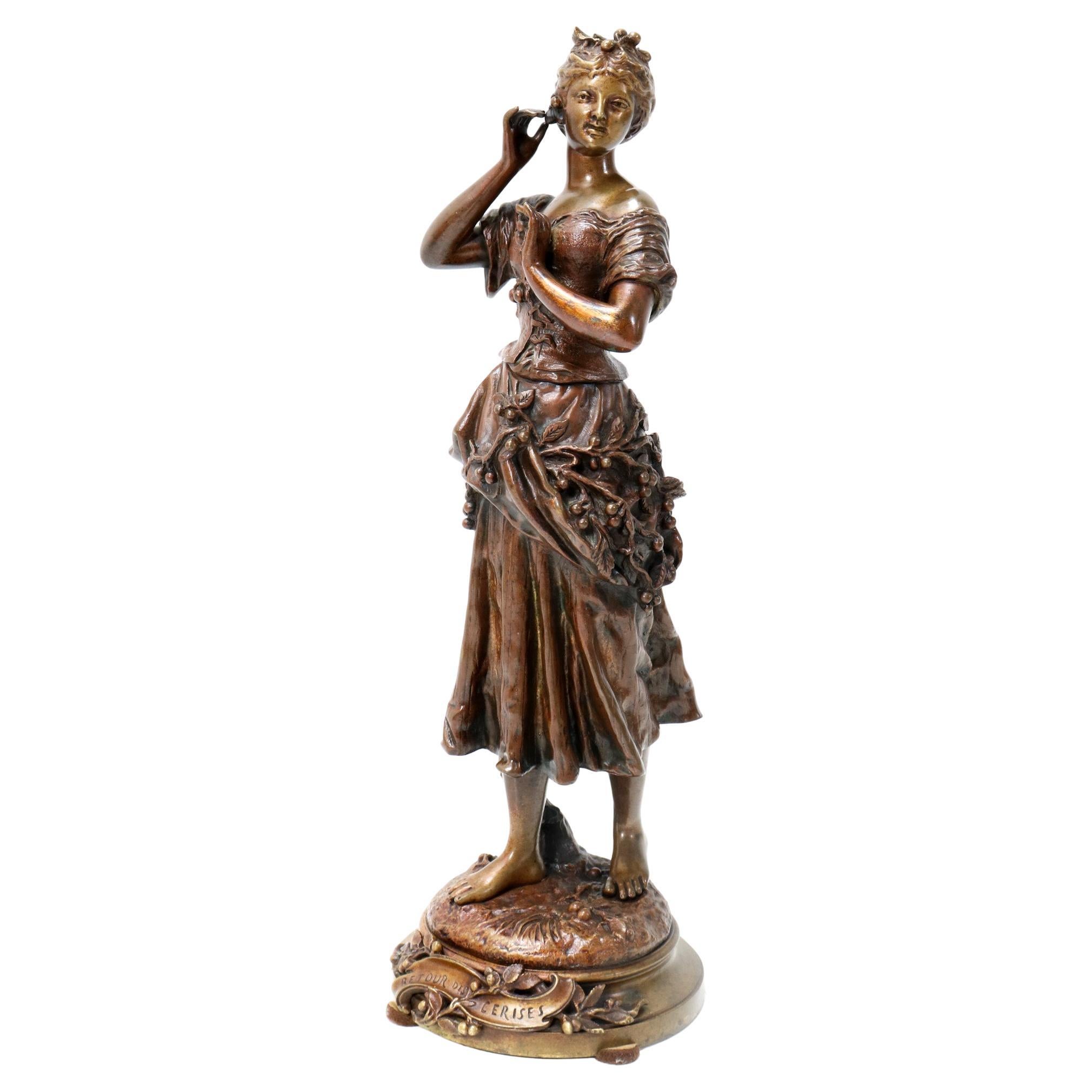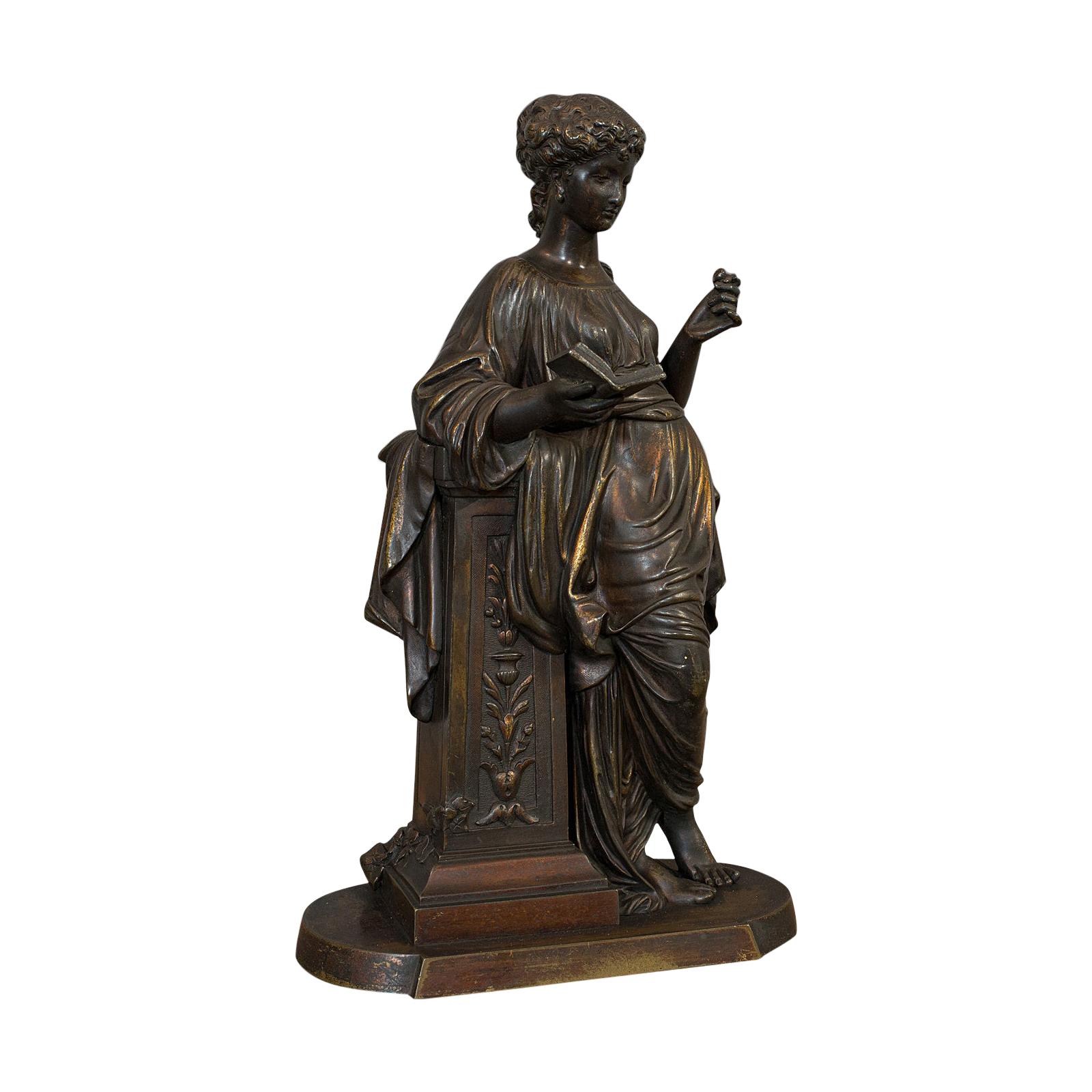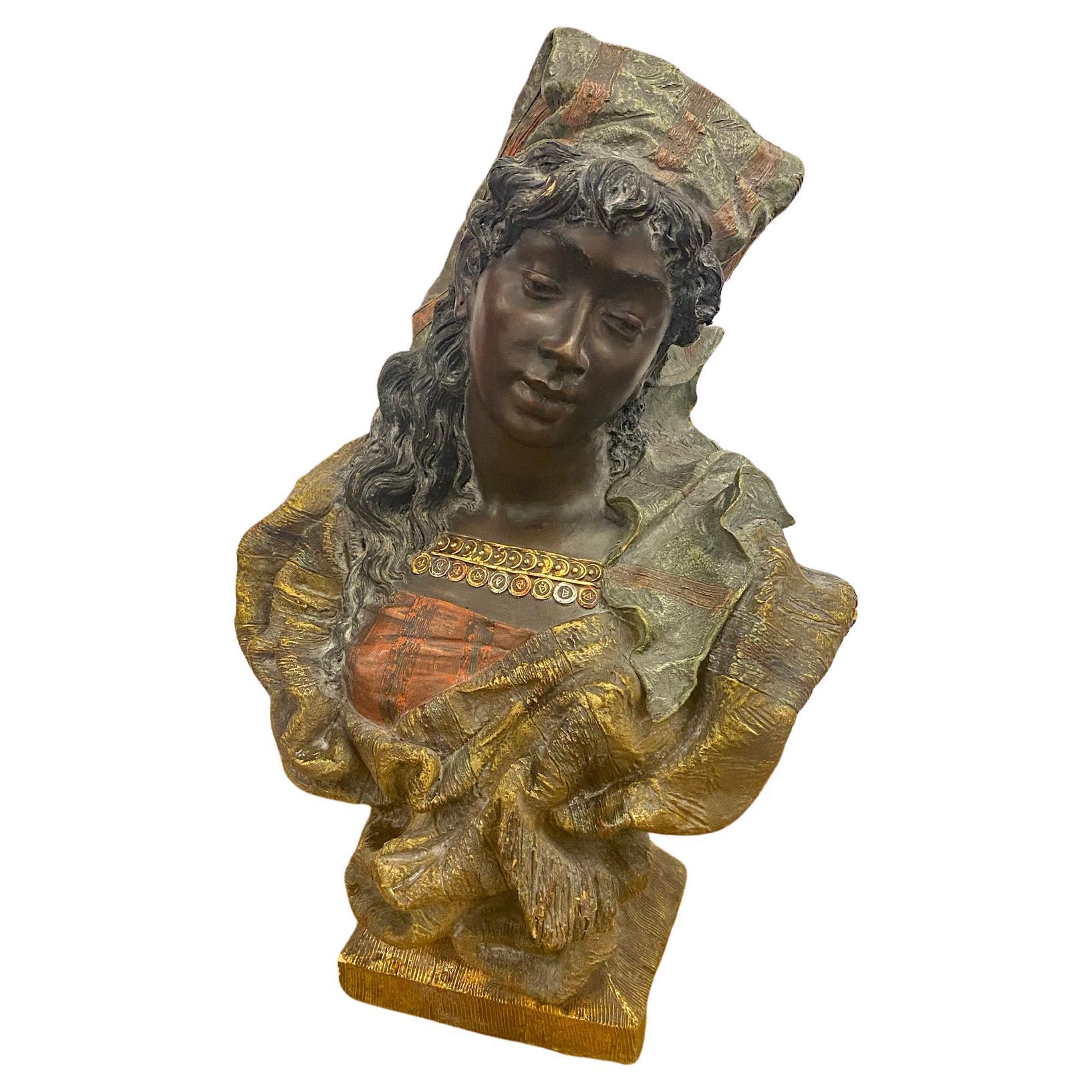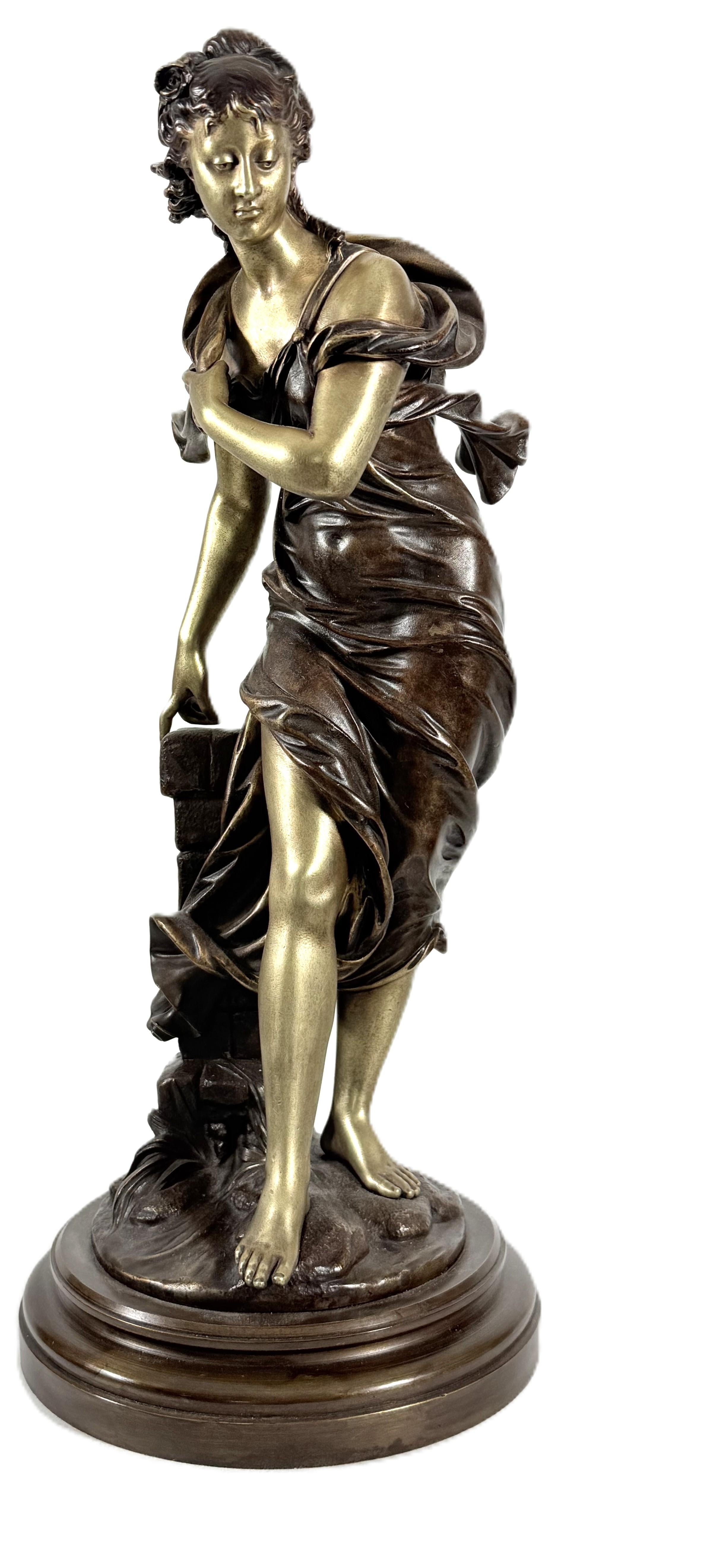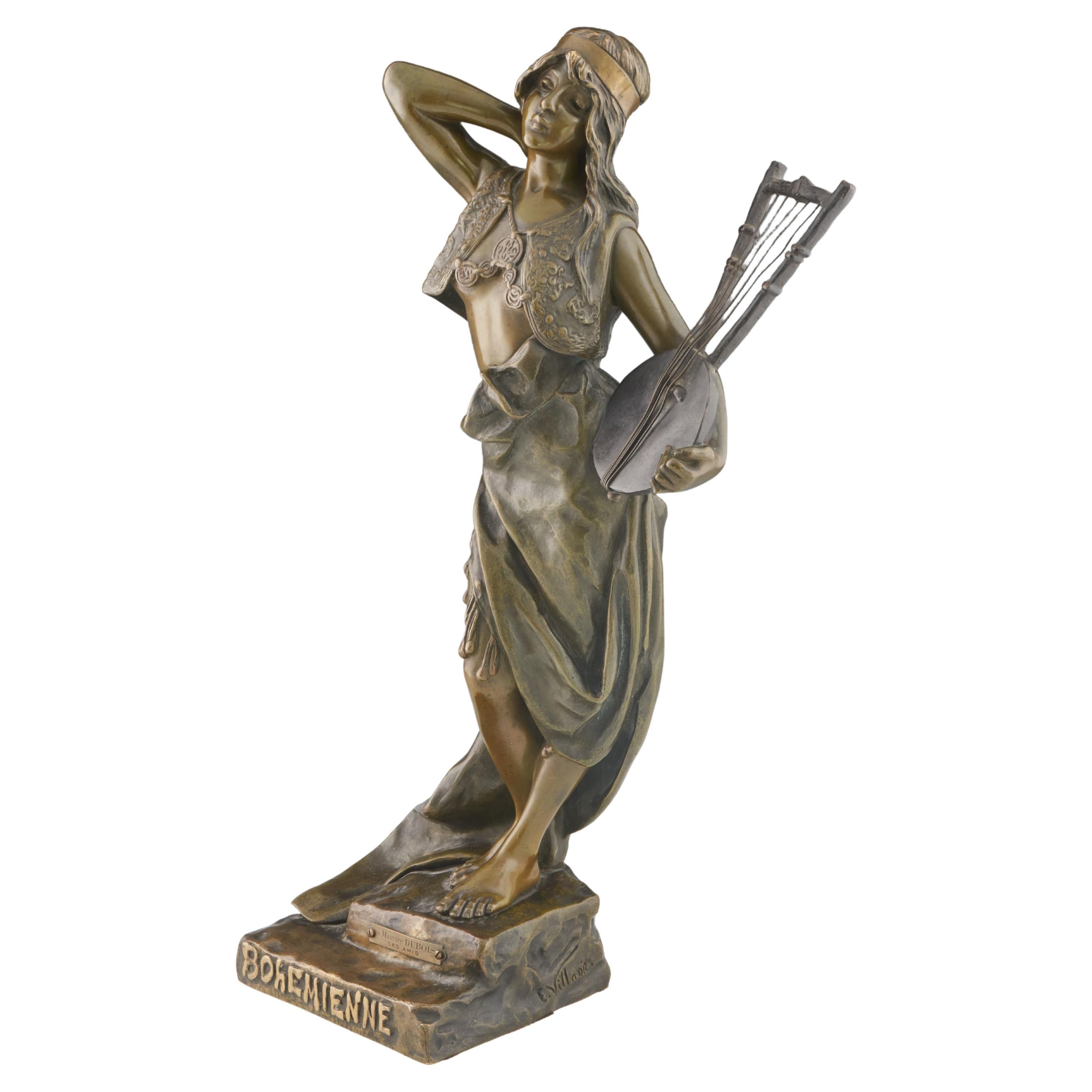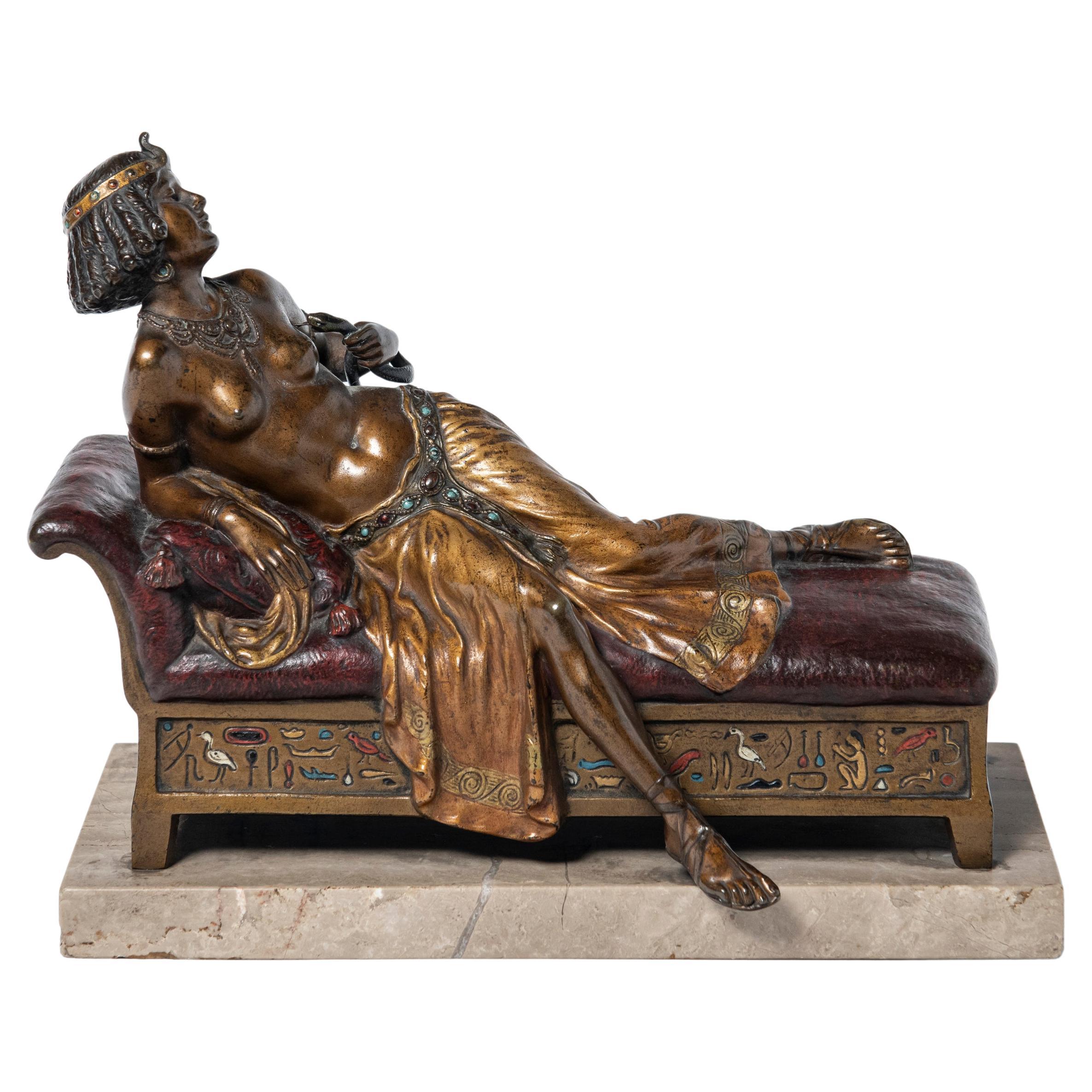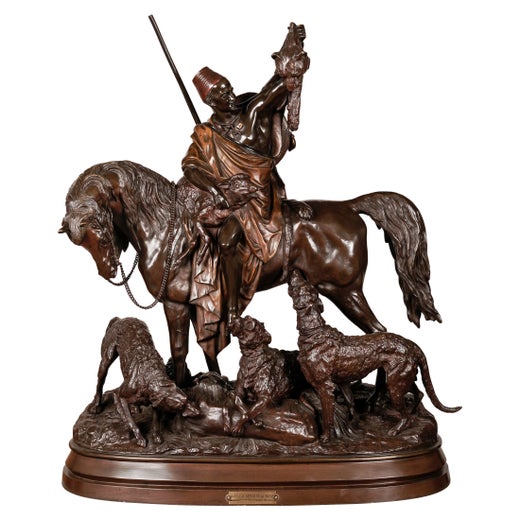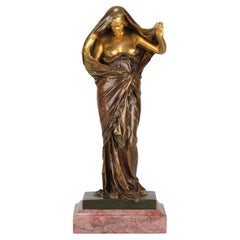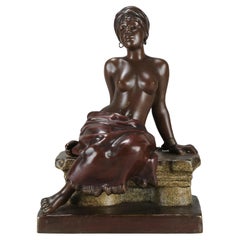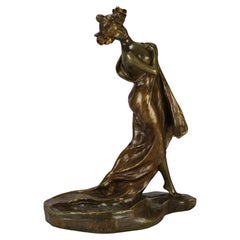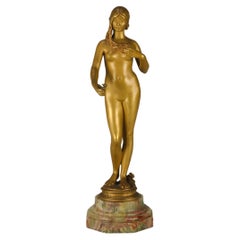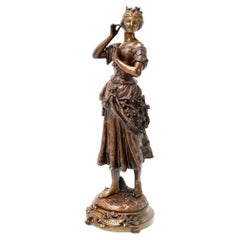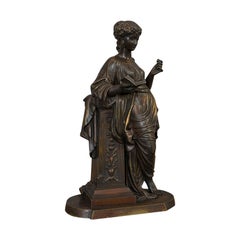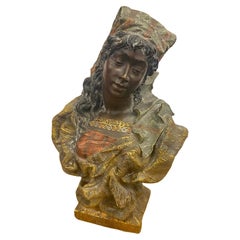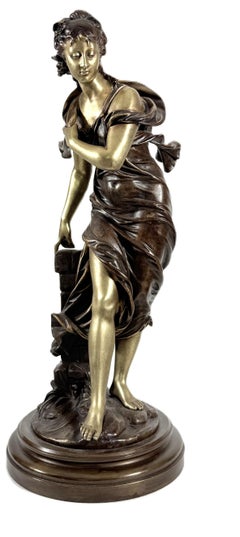Items Similar to Art Nouveau Polychromed Metal Sculpture "Romantic Beauty" by Arthur Waagen
Want more images or videos?
Request additional images or videos from the seller
1 of 11
Art Nouveau Polychromed Metal Sculpture "Romantic Beauty" by Arthur Waagen
$18,839.79
£13,750
€16,038.63
CA$25,805.80
A$28,701.69
CHF 14,987.13
MX$349,269.01
NOK 191,408.51
SEK 179,507.42
DKK 119,702.48
Shipping
Retrieving quote...The 1stDibs Promise:
Authenticity Guarantee,
Money-Back Guarantee,
24-Hour Cancellation
About the Item
An impressive late 19th century polychromed bronzed metal sculpture of an Orientalist maiden resting on a twin handled jardinière with excellent hand chased surface detail and fine naturalistic colours, signed Waagen
Arthur Waagen (German, 1833-1898) was born at Memel in Prussia, was a little-known German Animalier and orientalist figurative sculptor. Early in his career he moved to Paris, where he settled permanently to persue a career as a sculptor. His studio was based at 40, Cours de Vincennes, east of Place de la Nation. Inspired by the trend for the oriental, he exhibited several works with north African themes at the Paris salon from 1861 to 1887.
- Creator:Arthur Waagen 1 (Sculptor)
- Dimensions:Height: 33.08 in (84 cm)Width: 0 in (0.01 mm)Depth: 0 in (0.01 mm)
- Style:Other (Of the Period)
- Materials and Techniques:Metal,Cast
- Place of Origin:
- Period:
- Date of Manufacture:1890
- Condition:Wear consistent with age and use. Excellent. Excellent Original Condition Please note that our items are genuine antiques with considerable age. It is therefore normal that they will show some signs of wear and handling to the surface.
- Seller Location:London, GB
- Reference Number:Seller: SKU 83991stDibs: LU3216323837152
Arthur Waagen 1
Arthur Waagen was born in France. Waagen spent most of his life in Paris and was a well-respected animalier sculptor, but very little is known about his life. His most famous work is the large hunt group titled Kabyle au Retour de la Chasse of a North African horseman with his dogs and prey.
About the Seller
5.0
Gold Seller
Premium sellers maintaining a 4.3+ rating and 24-hour response times
Established in 1936
1stDibs seller since 2017
80 sales on 1stDibs
Typical response time: 1 hour
- ShippingRetrieving quote...Shipping from: London, United Kingdom
- Return Policy
Authenticity Guarantee
In the unlikely event there’s an issue with an item’s authenticity, contact us within 1 year for a full refund. DetailsMoney-Back Guarantee
If your item is not as described, is damaged in transit, or does not arrive, contact us within 7 days for a full refund. Details24-Hour Cancellation
You have a 24-hour grace period in which to reconsider your purchase, with no questions asked.Vetted Professional Sellers
Our world-class sellers must adhere to strict standards for service and quality, maintaining the integrity of our listings.Price-Match Guarantee
If you find that a seller listed the same item for a lower price elsewhere, we’ll match it.Trusted Global Delivery
Our best-in-class carrier network provides specialized shipping options worldwide, including custom delivery.More From This Seller
View AllLate 19th Century Art Nouveau Sculpture "Nature Unveiling" by Ernst Barrias
Located in London, GB
Wonderful late 19th Century Art Nouveau French bronze figure of a seductively draped female figure representing, in allegorical form, Nature revealing her secrets to Science, a fitti...
Category
Antique Late 19th Century French Art Nouveau Figurative Sculptures
Materials
Marble, Bronze
Late 19th Century Art Nouveau Bronze figure "Slave Girl" by Emmanuel Villanis
By Emmanuel Villanis
Located in London, GB
A beautiful patinated Art Nouveau bronze study of a young Art Nouveau beauty sat upon a wall wearing chains with excellent variegated rich brown patina and excellent hand chased surf...
Category
Antique Late 19th Century French Art Nouveau Figurative Sculptures
Materials
Bronze
Late 19th Century Art Nouveau Bronze "Nouveau Lady" by Georges Van Der Straeten
By Georges Van der Straeten
Located in London, GB
A delightful Art Nouveau Bronze figure of a young beauty scantily dressed with only a shawl draped across her body in a striking pose. The surface of the bronze with rich golden/brow...
Category
Antique Late 19th Century Belgian Art Nouveau Figurative Sculptures
Materials
Bronze
Early 20th Century Art Nouveau Bronze Entitled "La Jeuneuse" by Antonin Carlès
By Antonin Carlès
Located in London, GB
A delightful Art Nouveau early 20th Century gilt bronze figure of a very beautiful young lady holding a flower in her right hand, the surface of the bronze exhibiting fine detail and...
Category
Antique Early 1900s French Art Nouveau Figurative Sculptures
Materials
Bronze
"Delicate" by Paul Philippe
By Paul Philippe
Located in London, GB
An excellent French early 20th Century Art Deco bronze figure of a young attractive naked woman in an elegant pose with rich brown patination, raised on fitted green marble base & si...
Category
Early 20th Century French Art Nouveau Figurative Sculptures
Materials
Marble, Bronze
Early 20th Century Art Deco Gilt Bronze Sculpture "Isis" by Claire Colinet
By Claire Colinet
Located in London, GB
An exquisite early 20th Century French Art Deco gilt bronze figure of a young female dancer seated upon a shawl that she is lifting either side of her. The surface decorated with enamel painted ancient Egyptian design, exhibiting excellent colour and detail. Raised on a marble base and signed Cl.J.R.Colinet
ADDITIONAL INFORMATION
Height: 42 cm
Width: 56 cm
Depth: 21 cm
Condition: Excellent Original Condition
Circa: 1925
Materials: Bronze & Marble
Book Ref: Art Deco & Other Figures by Bryan Catley
Page: 117
SKU: 9176
ABOUT
Colinet
Claire Jeanne Roberte Colinet (1880–1950) was French sculptor of Belgian birth who worked during the early-to-mid 20th century. The subject matter of her best known work was primarily Arab female dancers. The majority of her career output in sculpture can be classified as being of the Art Deco style.
Colinet was a frequent exhibitor at the Salon des Artistes Francais and Salon des Independents art exhibitions in Paris. Her sculptures, most of which depicted beautifully figured, energized, and dramatic female forms, were exhibited posthumously at the Paris Salon for nearly 30 years.
Early Life
Colinet was born in Brussels, Belgium, in 1880. Little is known about her life other than the artwork she produced during a successful career that spanned more than 40 years. As a woman, she was in the minority in her chosen field of sculpture during the era in which she worked and lived.
Career
At an undetermined date – probably around 1910 – Colinet emigrated to Paris, France, where she studied sculpture under the watchful eye of Jef Lambeaux and exhibited for the first time at the Salon des Artistes Francais in 1913 and became a permanent member of the organization in 1929. From 1937 to 1940, she exhibited at the Salon des Independents in Paris and joined the Union of Women Painters and Sculptors. Colinet's work is primarily done in the Art Deco style, and her models included odalisques, exotic dancers, jugglers and artists of cabaret.
A number of her female dancer pieces were influenced by a revival of the Orientalism movement which had been popular in Europe from about 1860 to 1880. Her preferred casting material was bronze; however, a number of her most distinguished sculptures are chryselephantine, being a combination of both bronze and ivory.
Colinet's sculpture has become highly desirable to collectors and, increasingly, is selling for exorbitant sums. At a Christie's sale on 4 May 2007, her Ankara Dancer...
Category
Early 20th Century French Art Deco Figurative Sculptures
Materials
Bronze
You May Also Like
Late 19th Century Art Nouveau Bronze Retour Des Cerises by Charles Anfrie
By Charles Anfrie
Located in Amsterdam, NL
Stunning and rare Late 19th Century Art Nouveau sculpture.
Design by Charles Anfrie.
Striking French design from the 1890s.
This wonderful Late 19th Century Art Nouveau sculpture by Charles Anfrie is executed in patinated bronze and signed at the base with Retour Des Cerises.
This attractive young girl walks away happy after picking...
Category
Antique 1890s French Art Nouveau Figurative Sculptures
Materials
Bronze
$2,156 Sale Price
20% Off
Antique Bronze Figure, French, Female, Art Nouveau, After Moreau, circa 1920
Located in Hele, Devon, GB
This is an antique bronze figure. A French, female statue of Art Nouveau taste in the manner of Hippolyte François Moreau, dating to the early 20th century, circa 1920.
Sculpture ...
Category
Early 20th Century French Figurative Sculptures
Materials
Bronze
Goldscheider Terracotta "Marked, Austria, circa 1898
By Goldsheider
Located in Saint-Ouen, FR
Goldscheider terracotta "" Marked, Austria, circa 1898.
Category
Antique Late 19th Century Austrian Art Nouveau Figurative Sculptures
Materials
Terracotta
French antique bronze sculpture by Eutrope Bouret
By Eutrope Bouret
Located in Berlin, DE
This is an outstanding bronze statue of Eutrope Bouret, signed on the base, by the very well-known French artist Eutrope Bouret (1833-1906).
French antique bronze sculpture by Eutro...
Category
19th Century Art Nouveau Figurative Sculptures
Materials
Bronze
'Bohemienne' Art Nouveau Bronze Sculpture by Emmanuel Villanis, circa 1890
By Emmanuel Villanis
Located in Forest Row, East Sussex
'Bohemienne' An Art Nouveau bronze sculpture by Emmanuel Villanis (1858-1914), depicting an elegant young woman holding a lyre with her other arm raised behind her head with robes fl...
Category
Antique Late 19th Century French Art Nouveau Figurative Sculptures
Materials
Bronze
Painted bronze sculpture by Franz Bergmann signed Nam Greb. Austria, circa 1900.
By Franz Bergmann
Located in Buenos Aires, Buenos Aires
Painted bronze sculpture "Sacrifice of Cleopatra" by Franz Bergmann (1861-1936) signed Nam Greb, Austria, early 20th century.
Category
Antique Early 1900s Austrian Egyptian Revival Figurative Sculptures
Materials
Bronze
More Ways To Browse
Art Nouveau Metal Furniture
Oriental Sculpture
Art Nouveau Maiden
Oriental Jardiniere
Art Deco Medals
Large Porcelain Figure
Male Art Deco
Salon Des Beaux Arts Bronze
Art Deco Head Sculpture
Bronze Angel
Antique French Plaques
Used Bows And Arrows
Chinese Head Sculpture
French Marble Scale
Greek Bronze Figure
Made In Italy Statues
Mid Century Modern Italian Bronze Sculpture
Antique Bronze Relief
